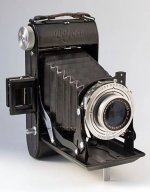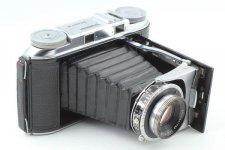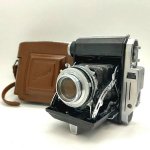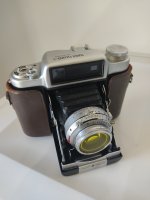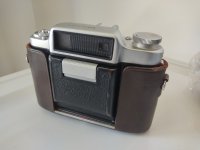Jason Schneider
the Camera Collector
My Four Favorite Rangefinder Roll Film Folders
Egad, medium format in a compact pocketable form factor!
By Jason Schneider
My first serious camera (not counting the atrocious plastic reflex viewing Ansco Panda box camera my Aunt Estelle gave me for my 10[SUP]th[/SUP] birthday) was a 6 x 9cm Belfoca, a decent but unremarkable East German folding camera I bought brand new at age 14 for the grand sum of $12.50 plus tax, money I’d earned on my paper route. It took 120 film and it had 2 covered red windows on the back, so you could shoot 6 x 4.5cm images by inserting the included film aperture mask, or full frame 6x9 without it. It had a good quality Prontor-S shutter with speeds of 1-1/250 sec plus B and (glory be!) a self-timer, and a 105mm f/4.5 E. Ludwig Meritar lens, a mediocre front cell focusing triplet that did OK if you stopped it down to about f/8. Despite my best efforts the Belfoca did not transform me into a world class photojournalist, but it was a “real camera,” and though it lacked a rangefinder it kindled my passion for medium format folding rangefinder cameras that continues to this day. Sadly, this once vibrant species is now extinct thanks to the demise of the last of the breed, the Fujifilm GF670 aka the Voigtlander Bessa III, that debuted 2008 and was quietly deep sixed in 2014.
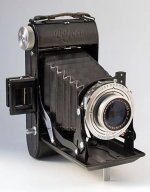
My first "real camera," the Belfoca was a modest scale focusing East German folder of the '50s but it helped me learn the fundamentals of photography.
I’ve always been a big fan of Zeiss Super Ikontas, which debuted in 1934 under the less compelling name Super Ikomat (which was swiftly dropped). They’re among the best made, most robust, durable, and ingenious rangefinder folders ever, and they originally came in 4 roll film sizes dubbed A, B, C, and D providing formats of 4.5 x 6, 6 x 6, 6 x 9, and 6.5 x 11 cm respectively. All took 120 roll film except for the rare giant Super Ikonta D that took 116 or 616 film, both officially defunct except for roll-your-own alternatives for those lucky enough to have spare paper backing and wide spools lying around. Zeiss in its infernal wisdom also assigned a bewildering succession of model numbers to these cameras—the original series began with the 530 and 520 series which gave way to the 531 and 521 series when a body shutter release and double exposure prevention were added. The original two eyepiece 6 x 6 cm Zeiss Super Ikonta B (aka the Super Six or model 530/16) gave way to the model 532/16 of 1937-1956, with a combined range/viewfinder and 80mm f/2.8 Tessar lens (coated after the war) and features an automatic frame counter, though you still have to position the first frame manually and cock the shutter before each exposure--and you only get 11 frames on a “12 exposure” roll. Boo.
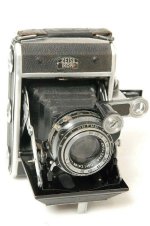
Zeiss Super Ikonta A, the smallest of the breed, it provided a 6x4.5cm format on 120 roll film. This one from the '30s has an uncoated 7.5 cm f/3.5 Tessar lens.
All classic vintage Super Ikontas have an ingenious way of coupling the rangefinder to the focusing mechanism of the lens—a circular optical element consisting of two contra-rotating prism wedges in a fixed (Super Ikonta B) or swing-out (Super Ikontas A, C, and D) extension, is positioned over the rangefinder window when the camera is unfolded, providing the secondary image that moves laterally as you turn the milled focusing wheel. The orange tinted rangefinder image is well defined and very easy to see, and the superimposed image system is quite accurate and seldom goes out of adjustment. The downsides of all Super Ikontas: their glorious Tessar lenses are front cell focusing (which compromises their off-axis performance at wide apertures) and they don’t focus close enough for head-and- shoulders portraits—the C and B only get down to 1.5 meters or 5 feet, and the A does only a bit better, focusing down to a skosh under 4 feet. The reward is that these cameras are very rigid in the open position, particularly the front standard, which is crucial in maintaining precise lens-to-film-plane alignment. The only Super Ikontas that used a conventional bed-mounted coupling arm for the rangefinder were the Zeiss Super Ikonta III and IV of 1956-1960 (catalog numbers 531/16 and 534/16 respectively), the latter with a built-in uncoupled selenium cell meter. Both had frame counters that were automatic (after you aligned the first frame) that gave a full 12 exposures per roll. Yay.
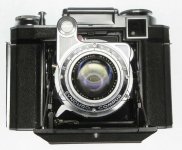
Zeiss Super Ikonta BX of the early '50s has a coated 80mm f/2.8 Zeiss-Opton Tessar lens and a built-in uncoupled meter, but only gave 11 exposures per roll!
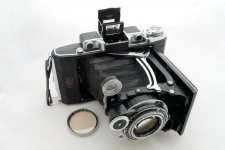
Zeiss Super Ikonta C late version with coated 10.5cm f:3.5 Zeiss-Opton Tessar lens in Synchro-Compur shutter. It's great, but only focuses down to 5 feet.
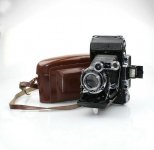
My favorite Super Ikonta? It's my Zeiss Super Ikonta C of 1936 with 10.5cm f:3.8 Carl Zeiss Jena Tessar lens in Compur-Rapid 1-1/400 sec plus B shutter.
While taking pictures with any Super Ikonta is ponderous and slow compared to, say, shooting with a 35mm SLR, their on-film performance is impressive, even by modern standards thanks to a combination of a large negative and excellent lenses. At apertures of f/5.6-16 an old Tessar, even an uncoated one, can give a modern digital camera a run for the money in terms of sharpness and detail, and they deliver classic vintage rendition and beautiful bokeh that sets the images apart. Over the years I’ve been lucky enough to acquire at least one example of every prewar and postwar Super Ikonta ever made except for the Super Ikonta D (because I’m a user-collector). My favorites are an early (1947) postwar Super Ikonta A (with a 1-1/500 sec plus B Compur-Rapid shutter and a coated 7.5cm f/3.5 Carl Zeiss Jena Tessar T lens, a 1936 Zeiss Super Ikonta C (model 531/2) with an uncoated 10.5cm f/3.8 Carl Zeiss Jena Tessar in a 1-1/400 sec plus B Compur-Rapid shutter, an early ‘50s Zeiss Super Ikonta BX (model 533/16) with a coated 80mm f/2.8 Zeiss-Opton Tessar in a Synchro-Compur MX 1-1/500 sec plus B shutter with self-timer, and a built-in uncoupled selenium meter, and a Zeiss Super Ikonta IV (model 534/16) of 1957 with a 75mm f/3.5 Tessar lens in a Synchro-Compur MXV 1-1/500 sec plus B shutter with self-timer and a working uncoupled selenium meter! The easiest one to shoot with is the Super Ikonta IV, which is a lot smaller, lighter, and more conveniently laid out than the BX. But my all-time favorite is that nearly 90-year-old Super Ikonta C, which somehow has more gravitas than even my mid ‘50s metered version of the same camera which has a coated 105mm f/3.5 Tessar and a working selenium meter. Maybe I’m just a sentimental old bat but that old uncoated 10.5cm f/3.8 Tessar seems to capture pictures that just look timeless.
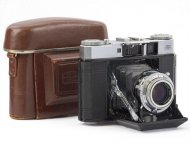
The last of the breed: The Super Ikonta IV of 1956-1960 was lighter and more compact than its 6x6 cm predecessors. It had a combined range/viewfinder, conventional mechanical rangefinder coupling, an improved frame counter, and an uncoupled selenium meter. Model III was the same camera sans meter.
The Germans offered a passel of cool folding roll film cameras with coupled rangefinders before and after WW II. They included the Weltur (by Welta) of the 1930s that was available in 6 x4.5, 6x6, and 6x9 cm formats, and the Certo 6 of the ‘50s, an advanced 6x6 folder with an 80mm f/2.8 Tessar lens and a parallax compensating range/viewfinder (!) that was made in the DDR. The original Plaubel Makina folding rangefinder cameras (available in 6x4.5 cm and 6.5x9 cm sizes) were wicked cool but they were primarily sheet film and film pack cameras. However, the relatively rare Plaubel Roll-Op of the '30s, made in nearly identical 6x4.5 cm and 6x6 cm versions, was a beautiful and well made rangefinder roll film folder with an automatic frame counter. Later folding roll film Plaubel Makina 67s of 1978 to the ‘80s were based on an entirely different design, had Nikkor lenses, and were made by DOI in Japan. The only German rangefinder roll film folders as successful as the Zeiss Super Ikontas were the much-acclaimed Voigtlander Rangefinder Bessa of 1936-1951 and its updated successor, the Voigtlander Bessa II of 1950-1956. Both were more technically sophisticated than all Zeiss Super Ikontas in providing unit focusing lenses that focus down to 1 meter (3.5 feet on footage models), and the Bessa II also haas combined range/viewfinders, a feature lacking on the Super Ikonta A and C (which had separate pop-up optical finders), the early Super Ikonta B (which has separate rangefinder and viewfinder windows), and present only on the last Super Ikontas, the III and IV.
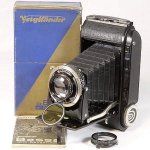
Voigtlander Rangefinder Bessa of 1936-1951 is beautifully finished in black. This gorgeous prewar example with uncoated lens is shown with close-up lens.
The Rangefinder Bessa (aka Bessa RF) is beautifully finished in black enamel and prewar examples had uncoated lenses—a 10.5 cm f/3.5 Skopar, Heliar or (3-element) Helomar in a Compur-Rapid 1-1/400 sec shutter, though some late postwar examples sported a coated 10.5 cm f/3.5 Color-Heliar. All featured a coupled split image rangefinder and separate viewfinder. About 60,000 were made over its 15-year production run. The Bessa II was basically the same camera but now with a superimposed image combined range/viewfinder and finished in satin chrome. It had (starting in 1951) a Synchro-Compur shutter and a choice of 3 coated lenses, a 10.5mm f/3.5 Color-Skopar or Color-Heliar or, from 1954-1956, the coveted 10.5 cm f/4.5 Apo-Lanthar. An accessory shoe was finally added in 1954 and total production for all 3 versions came to around 34,500. These are all elegant cameras, substantially smaller and lighter than a Zeiss Super Ikonta C, and all focus by means of an ingenious milled edge focusing wheel atop the lefthand side of the camera that has an adjacent depth of field scale. It’s connected to the front standard via a geared mechanism that’s connected to a coupling arm located inboard of the left-handed shutter release lever that emerges from the folding bed when you open the camera to shooting position.
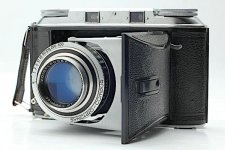
Late Voigtlander Bessa II with 105mm f/3.5 Color-Heliar lens in Synchro-Compur 1-1/500 sec plus B shutter. A delicate masterpiece with no frame counter.
In stark contrast to the optical sophistication of the design, neither the Rangefinder Bessa nor the Bessa II provides blank or double exposure prevention or an automatic frame counter—you must rely on ye olde red window, remember to wind the film to the next frame after taking each shot, and manually cock the shutter before each exposure. The front standard can hinge backward into the body when you press the camera closing key to release a catch that holds it vertically in place, but the entire mechanism is delicate, intolerant of abuse, and the Bessa’s front standard, while beautifully made, is not nearly as robust as the one in its chief rival, the Zeiss Super Ikonta C. Some have griped about the Bessa II’s range/viewfinder as being “too small and dinky” but it’s not bad at all and it’s truly no worse than those in many vintage rangefinder cameras such as screw-mount Canons and Leicas of the early ‘50s.mI don’t like the left-handed shutter release which feels tentative due to its coupling and is in the wrong place for a righty like me. If you’re lucky enough to find a Rangefinder Bessa or Bessa II in topnotch condition and proper adjustment, it’s an awesome camera capable of very impressive results. The 10.5 cm f/3.5 Skopar or Color Skopar is an excellent 4-element, 3-group Tessar type that’s “wiry sharp” and yields high contrast images; the 5-element, 3-group 10.5 cm f/3.5 Heliar or Color-Heliar is superb for portraits or landscapes, provides excellent detail rendition at somewhat lower contrast, and captures images with that classic “rounded vintage” look that’s virtually impossible to duplicate in Photoshop. The 10cm f/4.5 Apo-Lanthar, an apochromatic 5-element, 3-group variant based on the Heliar was created by legendary optical designer Albrecht Tronnier in 1954. Its front ring is adorned with red, green, and blue rings denoting its apochromatic correction. It’s a
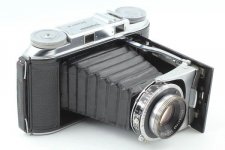
A collector's rare and pricey prize: Voigtlander Bessa II with 10.5cm f/4.5 Apo-Lanthar lens. Note RGB color rings on front denoting apochromatic correction.
pectacular performer and a rare pristine Bessa II so equipped now fetches, wait for it, 7-15k –I guess I shouldn’t have sold mine, eh- If you’ll settle for a nice clean Bessa II with a Color-Skopar be prepared to shell out $550-700, and $850-$1300 for one with a Color-Heliar. A prewar Rangefinder Bessa in good nick currently fetches about $300 with Skopar and $450 with Heliar lens. Warning: Getting them repaired is dodgy, and they have to be opened and folded with extreme care—and don’t ever press that rangefinder coupling arm by mistake!
If you’ll settle for a nice clean Bessa II with a Color-Skopar be prepared to shell out $550-700, and $850-$1300 for one with a Color-Heliar. A prewar Rangefinder Bessa in good nick currently fetches about $300 with Skopar and $450 with Heliar lens. Warning: Getting them repaired is dodgy, and they have to be opened and folded with extreme care—and don’t ever press that rangefinder coupling arm by mistake!
Two great Japanese folding rangefinder roll film classics
One of my all-time favorite rangefinder roll film folders is the Mamiya Six (not to be confused with the non-folding, interchangeable lens Mamiya 6 rangefinder camera introduced in 1989), which was designed by Mamiya Seiichi himself and introduced by the Mamiya Optical Co. of Tokyo way back in 1940 and produced in 14 (!) different iterations culminating in the Mamiya-6 Automat 2 of 1958. The main innovation in all these models is film plane focusing—rather than moving the lens back and forth to focus, the Mamiya Six moves the film plane using a milled thumbwheel located on the upper right-hand area of the back of the camera. The lens stays put. This brilliant idea eliminates the need for an elaborate optical or mechanical assemblage to connect the rangefinder to the lens.
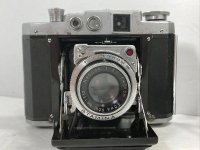
Original Mamiya Six of 1940s had a small built-in reflex finder in addition to range/viewfinder. Designed by Mr Mamiya himself it pioneered film plane focusing.
Mamiya Six History in Brief
The Mamiya Six I, II, and III, the wartime and immediate postwar models, had both eyelevel combined range/viewfinders and small reflex waist-level finders bult built into the body and the Model III added an exposure counter and double exposure prevention. The waist-level finder disappeared in the Mamiya Six IV introduced in 1947. The Mamiya Six V added dual 6x6 and 6x4.5 cm format capability, and the Mamiya Six IVB of 1955 introduced a new squarer body design and is identifiable by its square rangefinder window. There were also simplified models, The Mamiya Six K, based on the Model Six IV, and the model Six P based on the Mamiya Six IVS, the square bodied successor to the Six IVB. The final models were the Mamiya Six Automat which added a coupling to cock the shutter when you advance the film, and the final model, the Mamiya Six Automat 2, which had auto shutter cocking, and added a reflected non-parallax-correcting frame line in the finder. All Mamiya Six cameras are excellent picture takers that focus down to 1 meter, and all are fitted with high quality shutters, the majority by Copal or Seikosha (Seiko). All except the simplified models K and P have shutter speeds from 1-1/500 sec plus B, and most have Tessar-type 4-element lenses that perform very well indeed—on a par with the Zeiss originals. Mamiya Six cameras fitted with the 75mm f/3.5 Olympus Zuiko D F.C, Mamiya-Sekor, and Setagaya Koki Sekor S, all have 4-element lenses. Some claim that the Olympus Zuiko is a bit better than the Mamiya lenses, but I’ve never been able to see much of a difference. By the way, the Mamiya Six loading procedure is a bit idiosyncratic- you must slide out (or swing up) the “film positioning and tensioning plate” before you load the camera conventionally and then slide it back in or swing it down and lock it before closing the camera back and winding to the first frame.
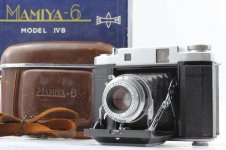
Mamiya Six IVB with 75mm f:3.5 D. Zuiko lens, a Tessar type made by Olympus, in a Seikosha-Rapid 1-1/500 plus B shutter, a fine Compur-Rapid knockoff.
The Mamiya Six (which is often engraved Mamiya-6 to add to the confusion) is a very pleasant camera to shoot with and it’s capable of outstanding results. It’s robust, well balanced, reasonably light, and its range/viewfinder is very good and easy to focus, if not quite as bright as those in more modern rangefinder cameras. I’m not a big fan of the left-handed film wind knob on top, but it’s the price you pay for the convenience of right-hand thumbwheel focusing. One of the best things about the Mamiya Six is that it's readily available at bargain prices. You can snag a clean fully functional Mamiya Six IV-series or V-series camera for around $150 or even less, and a pristine Mamiya Six Automat or Automat 2 can be purchased on the major online auction sites for around $250-$350. Many of these cameras are now 70 years old but these senior citizens of the camera world stand up rather well and they’re relatively easy to get fettled. My personal favorite is my awesome 1958 Mamiya Six Automat 2 with 75mm f/3.5 Mamiya-Sekor lens. I guess I’m a sucker for that reflected frame line in the finder even though it requires a little “Kentucky windage” on my part to achieve accurate framing at close portrait distances.
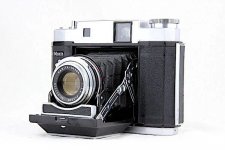
Last of the breed: Mamiya Six Automat 2 with 75mm f/3.5 Mamiya-Sekor lens. My fave, It has a fixed frame line finder and cocks the shutter when you wind..
The Konica Pearls: Jewels of the 6x4.5cm rangefinder roll film folders
The original Konica Pearl of 1949 was a 6x4.5 cm 120 roll film folder with an uncoupled rangefinder that may have taken its name from the Welta Perle of the ‘30s, a 6x4.5 folder with no rangefinder at all. The first Konica Pearl with a coupled rangefinder was the Pearl II of 1951, which was inscribed Pearl II on its top plate and has the focusing scale for its unit focusing 75mm f/4.5 Hexar lens in a window in the top housing. In 1952 a Tessar-type 75mm f/3.5 Hexar lens was added as an option. The less expensive Pearl IIB of 1955 retained the f/3.5 Hexar but substituted a Durax-S shutter with a 1/400 sec top speed for the Konirapid S 1/1-500 sec plus B shutter on the original Konica II. The Konica Pearl III introduced in late 1955 is inscribed Pearl III and adds a semi-auto (auto stop) frame counter (once the first frame is manually positioned and the counter set), eliminates the red window, and replaces the film advance key on previous models with a conventional knob. The model III also has a film reminder dial and a PC flash terminal. Later variants of the Pearl III, such as the Pearl IIIMX of 1956 replaced the Konirapid S shutter with a Seikosha-MX shutter. The final iteration, the Pearl IIIL employs a Seikosha MXL shutter with coupled LVS settings and has a new amber coating on the lens. It was succeeded by the radically redesigned Kobina Pearl IV of 1958, one if the greatest rangefinder roll film folders of all time.
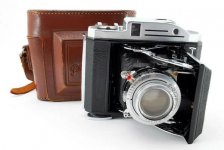
Konica Pearl II of 1951 was the first of the breed with a coupled range/viewfinder. This one has a 75mm f/3.5 Hexar lens in a Konirapid-S shutter by Konica.
The signature features of the landmark Konica Pearl IV are its brilliant, totally redesigned range/viewfinder with true projected frame lines illuminated by a translucent window, etched (but not moving) parallax compensation lines, an improved, more reliable automatic frame advance mechanism, and a traditionally placed frame counter atop the camera next to the film wind knob. The lens is a 4-element, 3-group 75mm f/3.5 f/3.5 Hexar in a double helical unit focusing mount, and the shutter is a 1-1/500 sec plus B Seikosha-MXL with LVS settings from 3 to 19. The lens focuses down to 1.2 meters (just under 4 feet). The frame lines in the finder and rangefinder patch are the brightest and clearest of any classic rangefinder folder, loading and spool insertion are simplified with pull out spool retainers and a clever locking system, and once the film has been loaded and lined up, just close the back, turn the film advance knob until it stops, and the counter will read “1.” Nits: you do have to cock the shutter manually for each exposure, and the camera must be set to infinity before folding it shut. Picks: the shutter release, a ribbed rectangular button on the door, operates with commendable smoothness, it’s impossible to cock the shutter until the film has been fully advanced to the next frame, and the camera has a centered cold shoe and standard tripod socket. Oh yeah, it’s also drop dead gorgeous!
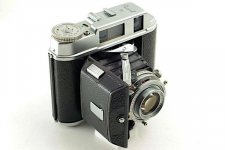
The last and greatest Konica Pearl IV of 1958 was completely redesigned to include a bigger, brighter projected frame line range/viewfinder and many other improvements. This angled right-hand view shows its distinctive ribbed rectangular shutter release atop the folding bed, and showcases its elegant form factor.
As you might imagine, the Konica Pearl IV is a blast to shoot with and the camera is capable of stellar on-film performance. My only gripes: I wish it focused down to 1 meter, and its desirability and scarcity have made it an overpriced (at least for me) cult classic. The Konica Pearl IV was in production for less than 2 years and reportedly only 4000-5000 were made, so while it may not qualify as truly rare it’s scarce enough since collectors have glommed onto a fair percentage of what’s out there. A nice clean one will set you back $500-$600, a mint one, around $750. You can of course settle for a less glorious Pearl III which runs about. $150-$300 in pristine shape. As for me, I’ll console myself with my near mint Fuji GS645 Professional folder, which is a little too big for my taste and has plastic outer body components, but at least its superb 5-element 75mm f/3.5 Fujinon S lens focuses down to 1 meter, it has projected finder frame lines that compensate for parallax and field frame size changes, and it has an excellent built-in meter.
Egad, medium format in a compact pocketable form factor!
By Jason Schneider
My first serious camera (not counting the atrocious plastic reflex viewing Ansco Panda box camera my Aunt Estelle gave me for my 10[SUP]th[/SUP] birthday) was a 6 x 9cm Belfoca, a decent but unremarkable East German folding camera I bought brand new at age 14 for the grand sum of $12.50 plus tax, money I’d earned on my paper route. It took 120 film and it had 2 covered red windows on the back, so you could shoot 6 x 4.5cm images by inserting the included film aperture mask, or full frame 6x9 without it. It had a good quality Prontor-S shutter with speeds of 1-1/250 sec plus B and (glory be!) a self-timer, and a 105mm f/4.5 E. Ludwig Meritar lens, a mediocre front cell focusing triplet that did OK if you stopped it down to about f/8. Despite my best efforts the Belfoca did not transform me into a world class photojournalist, but it was a “real camera,” and though it lacked a rangefinder it kindled my passion for medium format folding rangefinder cameras that continues to this day. Sadly, this once vibrant species is now extinct thanks to the demise of the last of the breed, the Fujifilm GF670 aka the Voigtlander Bessa III, that debuted 2008 and was quietly deep sixed in 2014.

My first "real camera," the Belfoca was a modest scale focusing East German folder of the '50s but it helped me learn the fundamentals of photography.
I’ve always been a big fan of Zeiss Super Ikontas, which debuted in 1934 under the less compelling name Super Ikomat (which was swiftly dropped). They’re among the best made, most robust, durable, and ingenious rangefinder folders ever, and they originally came in 4 roll film sizes dubbed A, B, C, and D providing formats of 4.5 x 6, 6 x 6, 6 x 9, and 6.5 x 11 cm respectively. All took 120 roll film except for the rare giant Super Ikonta D that took 116 or 616 film, both officially defunct except for roll-your-own alternatives for those lucky enough to have spare paper backing and wide spools lying around. Zeiss in its infernal wisdom also assigned a bewildering succession of model numbers to these cameras—the original series began with the 530 and 520 series which gave way to the 531 and 521 series when a body shutter release and double exposure prevention were added. The original two eyepiece 6 x 6 cm Zeiss Super Ikonta B (aka the Super Six or model 530/16) gave way to the model 532/16 of 1937-1956, with a combined range/viewfinder and 80mm f/2.8 Tessar lens (coated after the war) and features an automatic frame counter, though you still have to position the first frame manually and cock the shutter before each exposure--and you only get 11 frames on a “12 exposure” roll. Boo.

Zeiss Super Ikonta A, the smallest of the breed, it provided a 6x4.5cm format on 120 roll film. This one from the '30s has an uncoated 7.5 cm f/3.5 Tessar lens.
All classic vintage Super Ikontas have an ingenious way of coupling the rangefinder to the focusing mechanism of the lens—a circular optical element consisting of two contra-rotating prism wedges in a fixed (Super Ikonta B) or swing-out (Super Ikontas A, C, and D) extension, is positioned over the rangefinder window when the camera is unfolded, providing the secondary image that moves laterally as you turn the milled focusing wheel. The orange tinted rangefinder image is well defined and very easy to see, and the superimposed image system is quite accurate and seldom goes out of adjustment. The downsides of all Super Ikontas: their glorious Tessar lenses are front cell focusing (which compromises their off-axis performance at wide apertures) and they don’t focus close enough for head-and- shoulders portraits—the C and B only get down to 1.5 meters or 5 feet, and the A does only a bit better, focusing down to a skosh under 4 feet. The reward is that these cameras are very rigid in the open position, particularly the front standard, which is crucial in maintaining precise lens-to-film-plane alignment. The only Super Ikontas that used a conventional bed-mounted coupling arm for the rangefinder were the Zeiss Super Ikonta III and IV of 1956-1960 (catalog numbers 531/16 and 534/16 respectively), the latter with a built-in uncoupled selenium cell meter. Both had frame counters that were automatic (after you aligned the first frame) that gave a full 12 exposures per roll. Yay.

Zeiss Super Ikonta BX of the early '50s has a coated 80mm f/2.8 Zeiss-Opton Tessar lens and a built-in uncoupled meter, but only gave 11 exposures per roll!

Zeiss Super Ikonta C late version with coated 10.5cm f:3.5 Zeiss-Opton Tessar lens in Synchro-Compur shutter. It's great, but only focuses down to 5 feet.

My favorite Super Ikonta? It's my Zeiss Super Ikonta C of 1936 with 10.5cm f:3.8 Carl Zeiss Jena Tessar lens in Compur-Rapid 1-1/400 sec plus B shutter.
While taking pictures with any Super Ikonta is ponderous and slow compared to, say, shooting with a 35mm SLR, their on-film performance is impressive, even by modern standards thanks to a combination of a large negative and excellent lenses. At apertures of f/5.6-16 an old Tessar, even an uncoated one, can give a modern digital camera a run for the money in terms of sharpness and detail, and they deliver classic vintage rendition and beautiful bokeh that sets the images apart. Over the years I’ve been lucky enough to acquire at least one example of every prewar and postwar Super Ikonta ever made except for the Super Ikonta D (because I’m a user-collector). My favorites are an early (1947) postwar Super Ikonta A (with a 1-1/500 sec plus B Compur-Rapid shutter and a coated 7.5cm f/3.5 Carl Zeiss Jena Tessar T lens, a 1936 Zeiss Super Ikonta C (model 531/2) with an uncoated 10.5cm f/3.8 Carl Zeiss Jena Tessar in a 1-1/400 sec plus B Compur-Rapid shutter, an early ‘50s Zeiss Super Ikonta BX (model 533/16) with a coated 80mm f/2.8 Zeiss-Opton Tessar in a Synchro-Compur MX 1-1/500 sec plus B shutter with self-timer, and a built-in uncoupled selenium meter, and a Zeiss Super Ikonta IV (model 534/16) of 1957 with a 75mm f/3.5 Tessar lens in a Synchro-Compur MXV 1-1/500 sec plus B shutter with self-timer and a working uncoupled selenium meter! The easiest one to shoot with is the Super Ikonta IV, which is a lot smaller, lighter, and more conveniently laid out than the BX. But my all-time favorite is that nearly 90-year-old Super Ikonta C, which somehow has more gravitas than even my mid ‘50s metered version of the same camera which has a coated 105mm f/3.5 Tessar and a working selenium meter. Maybe I’m just a sentimental old bat but that old uncoated 10.5cm f/3.8 Tessar seems to capture pictures that just look timeless.

The last of the breed: The Super Ikonta IV of 1956-1960 was lighter and more compact than its 6x6 cm predecessors. It had a combined range/viewfinder, conventional mechanical rangefinder coupling, an improved frame counter, and an uncoupled selenium meter. Model III was the same camera sans meter.
The Germans offered a passel of cool folding roll film cameras with coupled rangefinders before and after WW II. They included the Weltur (by Welta) of the 1930s that was available in 6 x4.5, 6x6, and 6x9 cm formats, and the Certo 6 of the ‘50s, an advanced 6x6 folder with an 80mm f/2.8 Tessar lens and a parallax compensating range/viewfinder (!) that was made in the DDR. The original Plaubel Makina folding rangefinder cameras (available in 6x4.5 cm and 6.5x9 cm sizes) were wicked cool but they were primarily sheet film and film pack cameras. However, the relatively rare Plaubel Roll-Op of the '30s, made in nearly identical 6x4.5 cm and 6x6 cm versions, was a beautiful and well made rangefinder roll film folder with an automatic frame counter. Later folding roll film Plaubel Makina 67s of 1978 to the ‘80s were based on an entirely different design, had Nikkor lenses, and were made by DOI in Japan. The only German rangefinder roll film folders as successful as the Zeiss Super Ikontas were the much-acclaimed Voigtlander Rangefinder Bessa of 1936-1951 and its updated successor, the Voigtlander Bessa II of 1950-1956. Both were more technically sophisticated than all Zeiss Super Ikontas in providing unit focusing lenses that focus down to 1 meter (3.5 feet on footage models), and the Bessa II also haas combined range/viewfinders, a feature lacking on the Super Ikonta A and C (which had separate pop-up optical finders), the early Super Ikonta B (which has separate rangefinder and viewfinder windows), and present only on the last Super Ikontas, the III and IV.

Voigtlander Rangefinder Bessa of 1936-1951 is beautifully finished in black. This gorgeous prewar example with uncoated lens is shown with close-up lens.
The Rangefinder Bessa (aka Bessa RF) is beautifully finished in black enamel and prewar examples had uncoated lenses—a 10.5 cm f/3.5 Skopar, Heliar or (3-element) Helomar in a Compur-Rapid 1-1/400 sec shutter, though some late postwar examples sported a coated 10.5 cm f/3.5 Color-Heliar. All featured a coupled split image rangefinder and separate viewfinder. About 60,000 were made over its 15-year production run. The Bessa II was basically the same camera but now with a superimposed image combined range/viewfinder and finished in satin chrome. It had (starting in 1951) a Synchro-Compur shutter and a choice of 3 coated lenses, a 10.5mm f/3.5 Color-Skopar or Color-Heliar or, from 1954-1956, the coveted 10.5 cm f/4.5 Apo-Lanthar. An accessory shoe was finally added in 1954 and total production for all 3 versions came to around 34,500. These are all elegant cameras, substantially smaller and lighter than a Zeiss Super Ikonta C, and all focus by means of an ingenious milled edge focusing wheel atop the lefthand side of the camera that has an adjacent depth of field scale. It’s connected to the front standard via a geared mechanism that’s connected to a coupling arm located inboard of the left-handed shutter release lever that emerges from the folding bed when you open the camera to shooting position.

Late Voigtlander Bessa II with 105mm f/3.5 Color-Heliar lens in Synchro-Compur 1-1/500 sec plus B shutter. A delicate masterpiece with no frame counter.
In stark contrast to the optical sophistication of the design, neither the Rangefinder Bessa nor the Bessa II provides blank or double exposure prevention or an automatic frame counter—you must rely on ye olde red window, remember to wind the film to the next frame after taking each shot, and manually cock the shutter before each exposure. The front standard can hinge backward into the body when you press the camera closing key to release a catch that holds it vertically in place, but the entire mechanism is delicate, intolerant of abuse, and the Bessa’s front standard, while beautifully made, is not nearly as robust as the one in its chief rival, the Zeiss Super Ikonta C. Some have griped about the Bessa II’s range/viewfinder as being “too small and dinky” but it’s not bad at all and it’s truly no worse than those in many vintage rangefinder cameras such as screw-mount Canons and Leicas of the early ‘50s.mI don’t like the left-handed shutter release which feels tentative due to its coupling and is in the wrong place for a righty like me. If you’re lucky enough to find a Rangefinder Bessa or Bessa II in topnotch condition and proper adjustment, it’s an awesome camera capable of very impressive results. The 10.5 cm f/3.5 Skopar or Color Skopar is an excellent 4-element, 3-group Tessar type that’s “wiry sharp” and yields high contrast images; the 5-element, 3-group 10.5 cm f/3.5 Heliar or Color-Heliar is superb for portraits or landscapes, provides excellent detail rendition at somewhat lower contrast, and captures images with that classic “rounded vintage” look that’s virtually impossible to duplicate in Photoshop. The 10cm f/4.5 Apo-Lanthar, an apochromatic 5-element, 3-group variant based on the Heliar was created by legendary optical designer Albrecht Tronnier in 1954. Its front ring is adorned with red, green, and blue rings denoting its apochromatic correction. It’s a

A collector's rare and pricey prize: Voigtlander Bessa II with 10.5cm f/4.5 Apo-Lanthar lens. Note RGB color rings on front denoting apochromatic correction.
pectacular performer and a rare pristine Bessa II so equipped now fetches, wait for it, 7-15k –I guess I shouldn’t have sold mine, eh-
Two great Japanese folding rangefinder roll film classics
One of my all-time favorite rangefinder roll film folders is the Mamiya Six (not to be confused with the non-folding, interchangeable lens Mamiya 6 rangefinder camera introduced in 1989), which was designed by Mamiya Seiichi himself and introduced by the Mamiya Optical Co. of Tokyo way back in 1940 and produced in 14 (!) different iterations culminating in the Mamiya-6 Automat 2 of 1958. The main innovation in all these models is film plane focusing—rather than moving the lens back and forth to focus, the Mamiya Six moves the film plane using a milled thumbwheel located on the upper right-hand area of the back of the camera. The lens stays put. This brilliant idea eliminates the need for an elaborate optical or mechanical assemblage to connect the rangefinder to the lens.

Original Mamiya Six of 1940s had a small built-in reflex finder in addition to range/viewfinder. Designed by Mr Mamiya himself it pioneered film plane focusing.
Mamiya Six History in Brief
The Mamiya Six I, II, and III, the wartime and immediate postwar models, had both eyelevel combined range/viewfinders and small reflex waist-level finders bult built into the body and the Model III added an exposure counter and double exposure prevention. The waist-level finder disappeared in the Mamiya Six IV introduced in 1947. The Mamiya Six V added dual 6x6 and 6x4.5 cm format capability, and the Mamiya Six IVB of 1955 introduced a new squarer body design and is identifiable by its square rangefinder window. There were also simplified models, The Mamiya Six K, based on the Model Six IV, and the model Six P based on the Mamiya Six IVS, the square bodied successor to the Six IVB. The final models were the Mamiya Six Automat which added a coupling to cock the shutter when you advance the film, and the final model, the Mamiya Six Automat 2, which had auto shutter cocking, and added a reflected non-parallax-correcting frame line in the finder. All Mamiya Six cameras are excellent picture takers that focus down to 1 meter, and all are fitted with high quality shutters, the majority by Copal or Seikosha (Seiko). All except the simplified models K and P have shutter speeds from 1-1/500 sec plus B, and most have Tessar-type 4-element lenses that perform very well indeed—on a par with the Zeiss originals. Mamiya Six cameras fitted with the 75mm f/3.5 Olympus Zuiko D F.C, Mamiya-Sekor, and Setagaya Koki Sekor S, all have 4-element lenses. Some claim that the Olympus Zuiko is a bit better than the Mamiya lenses, but I’ve never been able to see much of a difference. By the way, the Mamiya Six loading procedure is a bit idiosyncratic- you must slide out (or swing up) the “film positioning and tensioning plate” before you load the camera conventionally and then slide it back in or swing it down and lock it before closing the camera back and winding to the first frame.

Mamiya Six IVB with 75mm f:3.5 D. Zuiko lens, a Tessar type made by Olympus, in a Seikosha-Rapid 1-1/500 plus B shutter, a fine Compur-Rapid knockoff.
The Mamiya Six (which is often engraved Mamiya-6 to add to the confusion) is a very pleasant camera to shoot with and it’s capable of outstanding results. It’s robust, well balanced, reasonably light, and its range/viewfinder is very good and easy to focus, if not quite as bright as those in more modern rangefinder cameras. I’m not a big fan of the left-handed film wind knob on top, but it’s the price you pay for the convenience of right-hand thumbwheel focusing. One of the best things about the Mamiya Six is that it's readily available at bargain prices. You can snag a clean fully functional Mamiya Six IV-series or V-series camera for around $150 or even less, and a pristine Mamiya Six Automat or Automat 2 can be purchased on the major online auction sites for around $250-$350. Many of these cameras are now 70 years old but these senior citizens of the camera world stand up rather well and they’re relatively easy to get fettled. My personal favorite is my awesome 1958 Mamiya Six Automat 2 with 75mm f/3.5 Mamiya-Sekor lens. I guess I’m a sucker for that reflected frame line in the finder even though it requires a little “Kentucky windage” on my part to achieve accurate framing at close portrait distances.

Last of the breed: Mamiya Six Automat 2 with 75mm f/3.5 Mamiya-Sekor lens. My fave, It has a fixed frame line finder and cocks the shutter when you wind..
The Konica Pearls: Jewels of the 6x4.5cm rangefinder roll film folders
The original Konica Pearl of 1949 was a 6x4.5 cm 120 roll film folder with an uncoupled rangefinder that may have taken its name from the Welta Perle of the ‘30s, a 6x4.5 folder with no rangefinder at all. The first Konica Pearl with a coupled rangefinder was the Pearl II of 1951, which was inscribed Pearl II on its top plate and has the focusing scale for its unit focusing 75mm f/4.5 Hexar lens in a window in the top housing. In 1952 a Tessar-type 75mm f/3.5 Hexar lens was added as an option. The less expensive Pearl IIB of 1955 retained the f/3.5 Hexar but substituted a Durax-S shutter with a 1/400 sec top speed for the Konirapid S 1/1-500 sec plus B shutter on the original Konica II. The Konica Pearl III introduced in late 1955 is inscribed Pearl III and adds a semi-auto (auto stop) frame counter (once the first frame is manually positioned and the counter set), eliminates the red window, and replaces the film advance key on previous models with a conventional knob. The model III also has a film reminder dial and a PC flash terminal. Later variants of the Pearl III, such as the Pearl IIIMX of 1956 replaced the Konirapid S shutter with a Seikosha-MX shutter. The final iteration, the Pearl IIIL employs a Seikosha MXL shutter with coupled LVS settings and has a new amber coating on the lens. It was succeeded by the radically redesigned Kobina Pearl IV of 1958, one if the greatest rangefinder roll film folders of all time.

Konica Pearl II of 1951 was the first of the breed with a coupled range/viewfinder. This one has a 75mm f/3.5 Hexar lens in a Konirapid-S shutter by Konica.
The signature features of the landmark Konica Pearl IV are its brilliant, totally redesigned range/viewfinder with true projected frame lines illuminated by a translucent window, etched (but not moving) parallax compensation lines, an improved, more reliable automatic frame advance mechanism, and a traditionally placed frame counter atop the camera next to the film wind knob. The lens is a 4-element, 3-group 75mm f/3.5 f/3.5 Hexar in a double helical unit focusing mount, and the shutter is a 1-1/500 sec plus B Seikosha-MXL with LVS settings from 3 to 19. The lens focuses down to 1.2 meters (just under 4 feet). The frame lines in the finder and rangefinder patch are the brightest and clearest of any classic rangefinder folder, loading and spool insertion are simplified with pull out spool retainers and a clever locking system, and once the film has been loaded and lined up, just close the back, turn the film advance knob until it stops, and the counter will read “1.” Nits: you do have to cock the shutter manually for each exposure, and the camera must be set to infinity before folding it shut. Picks: the shutter release, a ribbed rectangular button on the door, operates with commendable smoothness, it’s impossible to cock the shutter until the film has been fully advanced to the next frame, and the camera has a centered cold shoe and standard tripod socket. Oh yeah, it’s also drop dead gorgeous!

The last and greatest Konica Pearl IV of 1958 was completely redesigned to include a bigger, brighter projected frame line range/viewfinder and many other improvements. This angled right-hand view shows its distinctive ribbed rectangular shutter release atop the folding bed, and showcases its elegant form factor.
As you might imagine, the Konica Pearl IV is a blast to shoot with and the camera is capable of stellar on-film performance. My only gripes: I wish it focused down to 1 meter, and its desirability and scarcity have made it an overpriced (at least for me) cult classic. The Konica Pearl IV was in production for less than 2 years and reportedly only 4000-5000 were made, so while it may not qualify as truly rare it’s scarce enough since collectors have glommed onto a fair percentage of what’s out there. A nice clean one will set you back $500-$600, a mint one, around $750. You can of course settle for a less glorious Pearl III which runs about. $150-$300 in pristine shape. As for me, I’ll console myself with my near mint Fuji GS645 Professional folder, which is a little too big for my taste and has plastic outer body components, but at least its superb 5-element 75mm f/3.5 Fujinon S lens focuses down to 1 meter, it has projected finder frame lines that compensate for parallax and field frame size changes, and it has an excellent built-in meter.
Attachments
ranger9
Well-known
For once I agree with all these picks! (Okay, maybe I'd ditch the fragile Bessa in favor of something from Agfa...) Of course I'm biased about the Mamiya Six because I have one (a first-version Automat without the bright frame)...
Pál_K
Cameras. I has it.
The only folding rangefinders I have are Retina IIa’s - they are fine, but I’ve never been able to get used to the position of the focusing lever.
For medium format (6x6), folding, I have the Zeiss 515/16 - which is not a rangefinder. I’ve used it a lot on various cross-country trips in recent years. One thing I discovered is that my usual choice of f/5.6 or f/8 is not optimal - f/11 and even f/16 has produced the best results with its Novar Anastigmat lens.
For medium format (6x6), folding, I have the Zeiss 515/16 - which is not a rangefinder. I’ve used it a lot on various cross-country trips in recent years. One thing I discovered is that my usual choice of f/5.6 or f/8 is not optimal - f/11 and even f/16 has produced the best results with its Novar Anastigmat lens.
bluesun267
Well-known
I vote for the 6x6/645 convertible Olympus Chrome Six series folders.
I have a III and a RII both with the Zuiko 75mm f2.8 lens. Bodies are reasonably affordable and the lenses are sharp.
How many folders had lenses faster than f3.5? The only other one I can think of is the Ikonta B.
I have a III and a RII both with the Zuiko 75mm f2.8 lens. Bodies are reasonably affordable and the lenses are sharp.
How many folders had lenses faster than f3.5? The only other one I can think of is the Ikonta B.
santino
FSU gear head
Great picks, Jason!
A bit off topic: what was actually the first rangefinder camera ever? Probably not Leica, right?
A bit off topic: what was actually the first rangefinder camera ever? Probably not Leica, right?
Abbazz
6x9 and be there!
I agree with Jason picks. The Agfa Record III is of course nice but the front focusing lens place it a step below a Bessa. And most Record III require a full overhaul since the bellows and the helicoid grease don't age well.
I agree with the Mamiya Six being the most advanced 6x6 folder and a tremendously good value today.
I just want to add the Super Fujica-6, a little known 6x6 folder with coupled and combined rangefinder-viewfinder, "automatic" film advance, unit focusing lens and 1m minimum focus.
It's very uncommon in the West but easy to get by in Japan. It's not difficult to find a fully working sample in Japan for around $200.
It also looks quite nice!
Cheers!
Abbazz
I agree with the Mamiya Six being the most advanced 6x6 folder and a tremendously good value today.
I just want to add the Super Fujica-6, a little known 6x6 folder with coupled and combined rangefinder-viewfinder, "automatic" film advance, unit focusing lens and 1m minimum focus.
It's very uncommon in the West but easy to get by in Japan. It's not difficult to find a fully working sample in Japan for around $200.
It also looks quite nice!
Cheers!
Abbazz
Attachments
Abbazz
6x9 and be there!
ranger9
Well-known
A bit off topic: what was actually the first rangefinder camera ever? Probably not Leica, right?
Leica was not even close! Barring some obscure experiment, the first coupled-rangefinder camera was the Kodak 3A Special of 1916. (Right, folks?) This IS on topic because the Special WAS a folding roll-film rangefinder camera!
Those Leitz laggards didn't get around to adding a coupled rangefinder to the Leica until 1932.
Now, who's got a 3A Special and can tell us how awful it is to use in real life? I'm sure somebody on RFF has one...
DownUnder
Nikon Nomad
We could add hundreds of cameras to this 'list'. Many 1950s rangefinder 6x6s were superb shooters in their time. They still appeal to those of us who lean to minimalism in our photography - as cameras that do what they do without too much fuss, with just enough controls to make them interesting to play with.
I've owned a fair few in my time, but the two 6x6s I currently have are entirely suitable for my needs. A circa 1950 Zeiss Nettar with the 80/4.5 Novar lens and a direct viewfinder, which I use almost entirely for B&W street work. Also a Voigtlander Perkeo I with the legendary Color Skopar lens, ideal for color work.
I had a 6x9 Nettar but I found I didn't really bond with it, so I sold it last year to a young photographer who loves it and takes it out often for her landscape images.
Some years ago I came across a Bessa 6x6 with a Heliar lens, on sale in a charity shop in suburban Melbourne for AUD$90. I passed on it. I could kick myself...
I've owned a fair few in my time, but the two 6x6s I currently have are entirely suitable for my needs. A circa 1950 Zeiss Nettar with the 80/4.5 Novar lens and a direct viewfinder, which I use almost entirely for B&W street work. Also a Voigtlander Perkeo I with the legendary Color Skopar lens, ideal for color work.
I had a 6x9 Nettar but I found I didn't really bond with it, so I sold it last year to a young photographer who loves it and takes it out often for her landscape images.
Some years ago I came across a Bessa 6x6 with a Heliar lens, on sale in a charity shop in suburban Melbourne for AUD$90. I passed on it. I could kick myself...
das
Well-known
The Pearl IV is such a beautiful camera. If more people in the West had actually put their hands on one, it would talked about much more for sure.
Dewar01
Newbie
All good picks and beautiful cameras. I have an Agfa Record III which I've had for several years. Love it!
just recently purchased a Mamiya 6 - k2 dual format
And it's beautiful!
just recently purchased a Mamiya 6 - k2 dual format
And it's beautiful!
Retro-Grouch
Well-known
Just to be contrary, my vote goes to the Horseman 985, a 6x9 interchangeable-lens folding camera that puts the others to shame for versatility. Real handsome, too; I'm one of those shallow people who wants his cameras to look good!
OK, not pocketable. Though I never understood the idea of throwing a nice camera into a pocket full of loose change, car keys, lint, etc.
OK, not pocketable. Though I never understood the idea of throwing a nice camera into a pocket full of loose change, car keys, lint, etc.
Pál_K
Cameras. I has it.
No, no, no, no, no, my good man. As the Photographer, you keep your camera safely nestled in the silk lined pockets of your long coat whilst your servant handles the accessories such as cigars, handkerchiefs, film holders, all the while taking you about discreetly in your motorcoach.… I never understood the idea of throwing a nice camera into a pocket full of loose change, car keys, lint, etc.
Retro-Grouch
Well-known
No, no, no, no, no, my good man. As the Photographer, you keep your camera safely nestled in the silk lined pockets of your long coat whilst your servant handles the accessories such as cigars, handkerchiefs, film holders, all the while taking you about discreetly in your motorcoach.
Yes, indeed! And it is so refreshing to encounter such an expression of, dare I say, almost feline taste and refinement!
Share:
-
This site uses cookies to help personalise content, tailor your experience and to keep you logged in if you register.
By continuing to use this site, you are consenting to our use of cookies.


